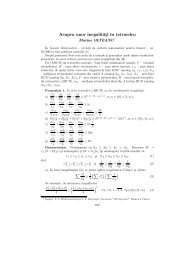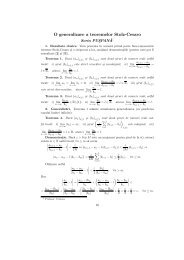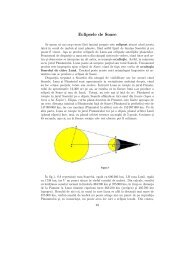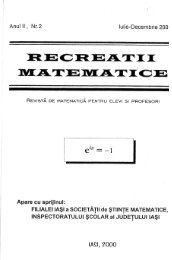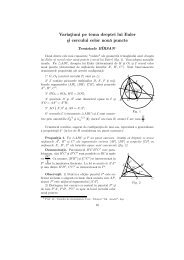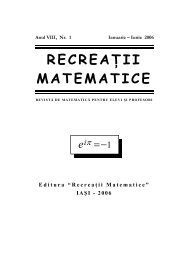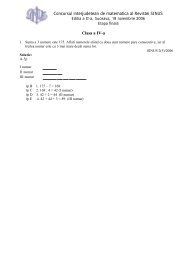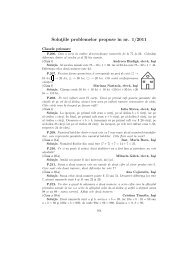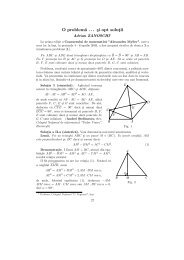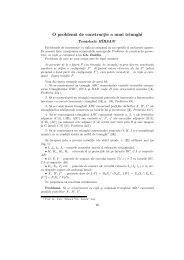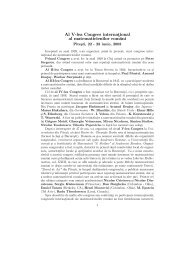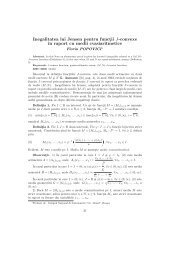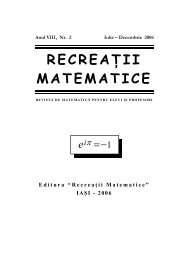Graphes et matrices de Moore
Graphes et matrices de Moore
Graphes et matrices de Moore
- No tags were found...
Create successful ePaper yourself
Turn your PDF publications into a flip-book with our unique Google optimized e-Paper software.
<strong>de</strong> Desargues. Dans c<strong>et</strong>te configuration - configuration <strong>de</strong> Desargues - il y a 10droites <strong>et</strong> 10 points; par chaque point il passe 3 droites <strong>et</strong> sur chaque droite il y a 3points. On représente c<strong>et</strong>te configuration par un graphe G = (S, A). Les somm<strong>et</strong>s <strong>de</strong>ce graphe sont les 10 points <strong>de</strong> la configuration <strong>de</strong> Desargues. Deux somm<strong>et</strong>s i <strong>et</strong> jsont reliés par une arête si <strong>et</strong> seulement si les points correspondants ne sont pas surune même droite. On obtient ainsi le 3-graphe <strong>de</strong> <strong>Moore</strong>, i.e. le graphe <strong>de</strong> P<strong>et</strong>ersenG ci-<strong>de</strong>ssus.Remarque. Pour d = 2, d = 3 <strong>et</strong> d = 7 on a montré l ′ existence <strong>de</strong>s d-graphes <strong>de</strong> <strong>Moore</strong>: graphes <strong>de</strong> P<strong>et</strong>ersen pour d = 3, n = 10 (voir le site web:http://mathematiques.ac-dijon.fr/ressources/graphes/jca/intro.htm), graphes<strong>de</strong> Hoffman – Singl<strong>et</strong>on pour d = 7, n = 50. Par contre, l ′ existence d ′ un 57-graphe <strong>de</strong> <strong>Moore</strong> n ′ a pas été encore démontré: un tel graphe aurait 3250 somm<strong>et</strong>s.Références1. A.J. Hoffman, R.R. Singl<strong>et</strong>on - On <strong>Moore</strong> Graphs with Diam<strong>et</strong>ers 2 and 3, IBMJ.Res. Develop., 5(4)(1960), 497-504.2. S.V. Duzhin - <strong>Graphes</strong> <strong>de</strong> <strong>Moore</strong> (démonstration <strong>de</strong> Chmutov),http://www.pdmi.ras.ru/ duzhin/papers/ .3. R.A. Brualdi , H.J. Ryser - Combinatorial matrix theory, Cambridge UniversityPress, 1991.(continuare <strong>de</strong> la pag. 22)Deci nu putem avea <strong>de</strong>cât A + B + C = 18 care, coroborată cu condiţia a doua aipotezei, impune rezultatului să fie format din cifrele 5, 6 respectiv 7, nu neapărat înaceastă ordine.Să găsim toate posibilităţile. Mai întâi, observăm că dacă schimbăm a cu a ′ , bcu b ′ şi c cu c ′ rezultatul nu se modifică (transformarea 1). Asta însemnă că, dacăfixăm un ”exemplu reprezentativ” (să zicem a < a ′ , b < b ′ şi c < c ′ ), se obţin 2 3posibilităţi. Apoi, observăm că, dacă are loc abc + a ′ b ′ c ′ = ABC, atunci are locşi bca + b ′ c ′ a ′ = BCA (transformarea 2). Asta înseamnă că pentru un exemplureprezentativ obţinem 2 · 2 3 = 16 posibilităţi.Următoarele două exemple sunt reprezentative 128+439 = 567 şi 218+439 = 657.Pentru primul exemplu obţinem: 128 + 439 = 567, 138 + 429 = 567, 129 + 438 = 567,139 + 428 = 567, 428 + 139 = 567, 438 + 129 = 567, 429 + 138 = 567, 429 + 138 =567 (conform transformării 1), la care aplicăm transformarea 2: 281 + 394 = 675,381 + 294 = 675, 291 + 384 = 675, 391 + 284 = 675, 284 + 391 = 675, 384 + 291 = 675,294 + 381 = 675, 294 + 381 = 675 - în total 16 posibilităţi. Analog pentru celălaltexemplu reprezentativ. Avem 2 · 16 = 32 posibilităţi.27



